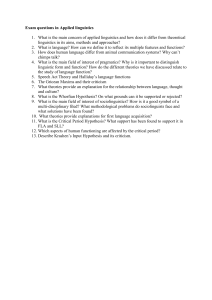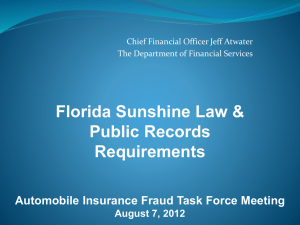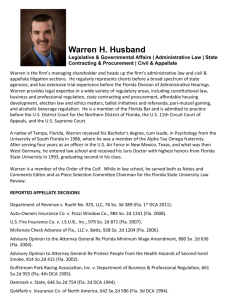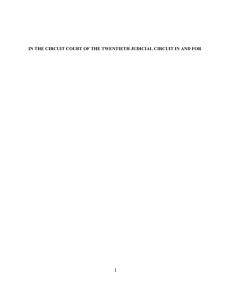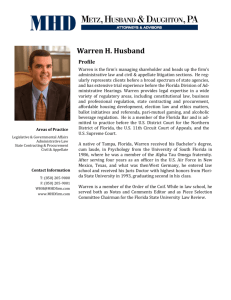Roper Premises Liability - Florida Association of Counties
advertisement
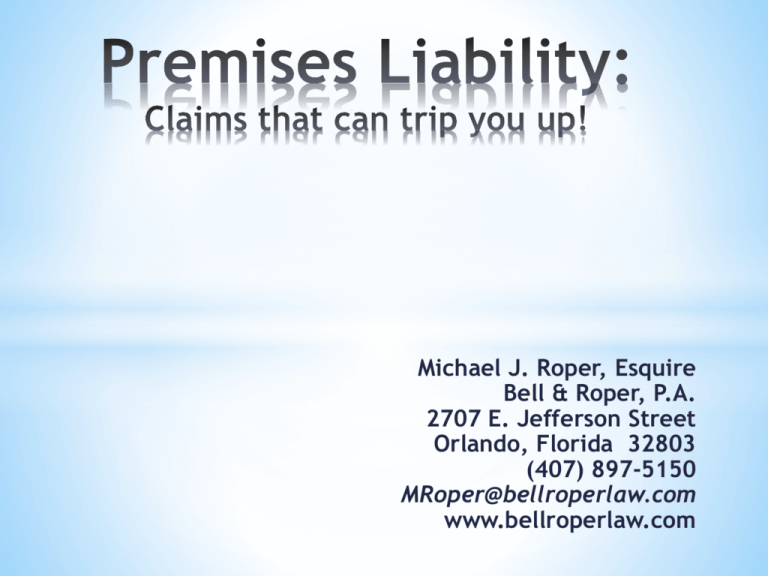
Michael J. Roper, Esquire Bell & Roper, P.A. 2707 E. Jefferson Street Orlando, Florida 32803 (407) 897-5150 MRoper@bellroperlaw.com www.bellroperlaw.com - Tort claim based upon principles of negligence - Sovereign immunity statute (§ 768.28, F.S.) implicated - Discretionary vs. operational distinction - $200,000/$300,000 cap on damages - Traditionally think of slip & falls; but also includes road defect; negligent security; drowning; recreational activities. - Negligence – Failure to use reasonable care - Doing something that a reasonably careful person would not do, under similar circumstances - Failing to do something that a reasonably careful person would do under like circumstances - Not strict liability - Landowner is not an insurer of the condition of the premises 2 Governmental entity owes same legal duty of care as a private landowner with respect to condition of premises owned, possessed or controlled. Maintenance and control of property deemed to be an “operational” activity – subject to suit. Duty to Invitee (1) Duty to maintain the premises in a reasonably safe condition; and (2) Duty to warn of hidden dangers which are known, or should be known, to landowner, but which are unknown to invitee and cannot be discovered by his exercise of due care. Collins v. Marriott Int’l, Inc., 749 F.3d 951, 960 (11th Cir. 2014) Friedrich v. Fetterman & Assocs., P.A., 137 So. 3d 362 (Fla. 2013) 3 - Important to note that these duties are independent of each other. - Open and obvious nature of hazard may discharge landowner’s duty to warn but does not discharge duty to maintain property in a reasonably safe condition. Rocamonde v. Marshalls of Ma., Inc., 56 So. 3d 863 (Fla. 3rd DCA 2011) - Can prevail on failure to warn claim but be found liable for negligent maintenance - Fact that claimant who slipped and fell was unaware of the puddle of water does not bar claim for negligent maintenance. Mashni v. LaSalle Partners Management Ltd., 842 So. 2d 1035 (Fla. 4th DCA 2003) - The converse is true, as well. Property can be well maintained, but if there is a latent danger, not susceptible to maintenance, still have a duty to warn. (i.e.) curve in road, cannot be safely negotiated at speed in excess of 30 mph. 4 Duty to Licensee Licensee – a person who enters upon premises solely for his own convenience, pleasure or benefit and whose presence is tolerated by landowner. - Refrain from willful misconduct or wanton negligence - Warn of known dangers which are not open and obvious - Refrain from intentionally exposing licensee to danger Duty to Trespasser - To avoid willful and wanton injury - If trespasser is discovered, to warn of known dangers which are not open and obvious. 5 - Landowner’s duty of care is non-delegable - Liability cannot be contracted away by entering into agreement with a maintenance or cleaning company; management company, etc. - Landowner may have contractual claim for indemnity/ reimbursement from management company, but does not eliminate his potential liability to an injured claimant. Pembroke Lakes Mall Ltd. v. McGruder, 137 So. 3d 418 (Fla. 4th DCA 2014) 6 Road Defect Claims Liability arising out of ownership and maintenance of roadways represents significant financial exposure to all governmental entities 7 Significant verdicts in roadway defect cases Citrus Co. v. McQuillin, 840 So.2d 343 (Fla. 5th DCA 2000) - Roadside defect: 3-5 in. Vehicle rollover Wrongful death – wife and mother Verdict: $5.56 million 8 Significant verdicts in roadway defect cases (cont’d) Cullison v. Orange Co., 9th Jud. Cir. Ct., No. CIO02-2502 - Failure to install traffic light at known dangerous intersection - Orthopedic injuries; coma for 8 mos.; brain damage - Verdict: $11.86 million (later court reduced to $11.39 million) 9 General Legal Principles Design - Decisions relating to the design of highways, including (a) the location and alignment of roads, (b) number of lanes, and (c) placement of medians or traffic control devices, are discretionary, planning level decisions and governmental entities are immune from tort liability. DOT v. Neilson, 419 So.2d 1071 (Fla. 1982). Improve/Upgrade - Decisions whether to improve or upgrade existing facilities are discretionary functions and sovereign immunity applies. Perez v. Dade County, 662 So.2d 421 (Fla. 3rd DCA 1995); Leonard v. Wakulla Co., 688 So.2d 440 (Fla. 1st DCA 1997). 10 General Legal Principles (cont’d) Hidden “trap” - Exception to the rule: When a governmental entity creates a known, dangerous condition, which is not readily apparent to persons who could be injured, an operational level duty arises to warn the public of, or protect the public from, the known danger. City of St. Petersburg v. Collom, 419 So.2d 1082 (Fla. 1982). - Courts have clarified this exception applies only where there is a known hazard so serious and so inconspicuous to a foreseeable plaintiff that it virtually constitutes a “trap.” Cygler v. Presjack, 667 So.2d 458 (Fla. 4th DCA 1996); Scott v. FDOT, 752 So.2d 30 (Fla. 1st DCA 2000). - Fourth DCA refused to apply the exception in a case where the design of the intersection, although admittedly confusing, was not sufficient to constitute a “trap;” recognizing that “a certain level of hazard is intrinsic and unavoidable of roadway construction and in the management of traffic flow.” FDOT v. Allen, 768 So.2d 496 (Fla. 4th DCA 2000).; See e.g., DOT v. Konney, 587 So.2d 1292 (Fla. 1991) (stating virtually every intersection may be inherently dangerous). 11 General Legal Principles (cont’d) Maintenance - Governmental entity may be held liable for failing to properly maintain existing roads. DOT v. Neilson, 419 So.2d 1071 (Fla. 1982); Tucker v. Gadsden Co., 670 So.2d 1053 (Fla. 1st DCA 1996). - Government entity cannot convert a maintenance function into a planning level activity to which sovereign immunity attaches by refraining from inspection or maintenance of existing facilities, or by adopting a policy of non-inspection. Simmonds-Hewett v. Keaton, 626 So.2d 249 (Fla. 4th DCA 1993). 12 Liability for Trees - Landowner is not liable for damage (BI or PD) caused by tree or limb which falls, unless it would have been apparent to a reasonable person that the tree/limb was dead, diseased or in need of removal/trimming. - Landowner not liable for damage caused by tree roots or natural vegetation encroaching onto neighbor’s land. - Neighbor is permitted to remove/trim, at his expense, any encroaching roots or limbs. - Private property owner does not have a duty to maintain roots which encroach onto a public right of way. Sullivan v. Silver Palm Properties, 558 So. 2d 409 (Fla.1990) 13 Liability for Trees (cont’d) - But landowner has duty to trim/remove foliage/landscaping which encroaches on public roadway and obstructs traffic signage or visibility to motorists. Morales v. Costa, 427 So. 2d 297 (Fla. 3d DCA 1983) - Owners or occupiers of commercial property can be liable for obstructions to vision, located entirely upon their property, if it is foreseeable that would cause a danger to pedestrians or other motorists. Whitt v. Silverman, 788 So. 2d 210 (Fla. 2001) - Owner of non-commercial property is not liable for natural vegetation, located entirely within the boundaries of his property, even if that vegetation impaired visibility of motorist. Williams v. Davis, 974 So. 2d 1052 (Fla. 2007) 14 Transitory Substances - § 768.0755, Florida Statutes – applies to existence of transitory substances in a business establishment, effective July, 2010. - “Business establishment” defined as “…location where business is conducted, goods are made or stored or processed or where services are rendered.” Publix Supermarkets, Inc. v. Santos, 118 So.3d 317 (Fla. Dist. Ct. App. 2013) - Term interpreted to include: (a) Public Community Colleges – McCarthy v. Broward College, 164 So.2d 78 (Fla.4th DCA 2015); (b) Miami International Airport - Kenz v. Miami-Dade County, 116 So.3d 461 (Fla. 3d DCA 2013); (c) U.S. Postal facility – Kertz v. U.S., 2013 WL 1464180 (M.D. Fla. 2013) - Requires injured person to prove that business establishment (i) had actual or constructive knowledge of the dangerous condition and, (ii) should have taken action to remedy it. 15 Transitory Substances (cont’d) - Injured party can prove constructive notice by way of circumstantial evidence showing (i) that the condition had existed for such a length of time that landowner should have known of its existence, or (ii) the condition occurred with regularity and was, therefore, foreseeable. - Plaintiff failed to present evidence of actual or constructive notice by landowner where he only produced evidence that floor was wet and he slipped and fell. - There was no evidence of how long the slippery substance was on the floor, or evidence to show landowner had caused or had actual notice of the spill. Vallot v. Logan's Roadhouse, Inc., 567 F. App'x 723 (11th Cir. 2014) 16 Attractive Nuisance - Exception to the general duty of care owed to a trespasser - Applies only to child trespassers and child licensees - Under the attractive nuisance doctrine, a property owner is liable for injuries suffered by a child trespasser if: - The property owner knows or has reason to know that the place where the dangerous condition exists is one where children will likely trespass 17 Attractive Nuisance (cont’d) - The condition is known or should be known to cause an unreasonable risk of bodily harm to a trespassing child (i.e., constitute a trap or latent danger) - The child because of his or her age does not discover the condition or realize the risk involved in intermeddling with it or in coming within the area made dangerous by it - The burden of eliminating the danger is slight compared to the risk posed to children - The property owner fails to exercise reasonable care in removing the danger or protecting the child - Must have enticed the child onto the property 18 Attractive Nuisance - Particular Cases There is no liability for a child's drowning in a body of water, natural or artificial, unless there is some unusual danger not generally existing in similar bodies of water or the water contains a dangerous condition constituting a trap. Allen v. William P. McDonald Corp., 42 So.2d 706 (Fla.1949); Gilbertson v. Lennar Homes, 629 So.2d 1029 (Fla. 4th DCA 1993) rev. den. 639 So.2d 979. The lake's sharp change in depth is characteristic of lakes and does not constitute a concealed dangerous condition. Kinya v. Lifter, Inc., 489 So.2d 92 (Fla. 3d DCA 1986) (artificial bank's slope not so different from natural bodies of water) Construction Sites - A building under construction is not per se an attractive nuisance. Concrete Construction v. Petterson, 216 So. 2d 221 (Fla. 1968). 19 Attractive Nuisance - Particular Cases (cont’d) - The Supreme Court of Florida has, however, upon several occasions found that what it termed an attractive nuisance existed upon premises where a building was in the process of construction . E.g., Atlantic Peninsular Holding Co. v. Oenbrink, 1938, 133 Fla. 325, 182 So. 812 (concrete floor collapsed due to latent defects); Johnson v. Wood, 1945, 155 Fla. 753, 21 So.2d 353 (unprotected mortar box placed near sidewalk and containing caustic ingredients). Swimming pools - there is sufficient “allurement” where defendants, when not at home, left open a door in a swimming pool enclosure and left a hose at the edge of the pool through which water was running, the sound of which was audible outside the enclosure. Samson v. O’Hara, 239 So.2d 151 (Fla. 2nd DCA 1970) “Monkey bars” not inherently dangerous condition or trap, for purposes of attractive nuisance doctrine. Alegre v. Shurkey, 296 So.2d 247 (Fla. 1st DCA 1981) 20 Liability for Dangerous Conditions of Adjacent Property - As part of duty to maintain premises in a reasonably safe condition, property owner also has a duty to maintain property to prevent foreseeable issues that exist on adjacent property. - Private school with buildings located on opposite sides of highway necessitating frequent crossings by students owed duty of care to student struck by motorcycle while crossing highway. Almarante v. Art Inst. of Fort Lauderdale, Inc., 921 So. 2d 703, 705 (Fla. 4th DCA 2006) - Golf club held liable when golfer fell to his death from cliff located on adjacent property, accessible only from golf club property. Danger was foreseeable, hence triggering duty of care. Collins v. Marriott Int’l, Inc., 749 F.3d 951, 960 (11th Cir. 2014) 21 Violation of Statute, Policy, Industry Standard Violation of statute is: (a) Negligence per se if statute establishes a duty to take precaution to protect a particular class of persons from a particular type of injury, and plaintiff is in that class and suffers that type of injury (b) Evidence of negligence, if statute establishes a general duty of care for public, in general Violation of internal policy/rule is relevant evidence on the standard of care and admissible at trial, but does not necessarily establish a legal standard of care Mayo v. Publix Super Mkts., Inc., 686 So.2d 801, 802 (Fla. 4th DCA 1997); aff’d Pollock v. Fla. Dep't of Highway Patrol, 882 So. 2d 928, 932 (Fla. 2004). Violation of industry standards is evidence of negligence. Seaboard Coast Line R. Co. v. Clark, 491 So.2d 1196 (Fla. 4th DCA 1986) 22 Common Defenses a. Duty to maintain i. No notice, premises routinely inspected, repaired, maintained ii. Facility recently constructed or installed, in good repair, therefore, no requirement for maintenance iii. Facility is such that routine inspection or repair is not reasonably contemplated – manufacturer’s specifications; useful life expectancy iv. Comparative negligence v. Condition not unreasonably dangerous or expected to cause injury, therefore, premises reasonably maintained 23 FLORIDA DEPARTMENT OF TRANSPORTATION MAINTENANCE RATING PROGRAM HANDBOOK 2012 2015 24 FLORIDA DEPARTMENT OF TRANSPORTATION MAINTENANCE RATING PROGRAM HANDBOOK 2012 2015 25 Common Defenses (cont’d) a. Duty to warn i. No notice – actual or constructive ii. Condition open and obvious iii. Condition known or could be reasonably discovered by claimant iv. Comparative negligence 26 Failure to Warn Open and obvious: Conditions found by courts to be “open and obvious” and, therefore, not dangerous, as a matter of law, for pedestrians. Landscaped area, consisting of dirt, grass, trees, and mulch, not designed for pedestrian traffic where property owner provided available adjacent concrete walkway. Wolf v. Sam’s East, Inc., 132 So.3d 305 (Fla. 4th DCA 2014) rev. den. 151 So.3d 1231; City of Melbourne v. Dunn, 841 So. 2d 504 (Fla. 5th DCA 2003). 27 Failure to Warn (cont’d) A wheel stop in a parking space Ramsey v. Home Depot U.S.A., Inc., 124 So. 3d 415 (Fla. 1st DCA 2013) Steps & elevation changes that have similar colored surfaces Gorin v. City of St. Augustine, 595 So. 2d 1062 (1992); Aventura Mall Venture v. Olson, 561 So. 2d 319 (Fla. Dist. Ct. App. 1990) Uneven parking lot pavement Circle K Convenience Stores, Inc. v. Ferguson, 556 So. 2d 1207 (Fla. 5th DCA 1990) Multiple floor levels or existence of steps Rice v. Whitehurst, 778 So.2d 1027, 1028 (Fla. 4th DCA 2001) Note: factors such as lighting, distraction, weather, visibility, unique circumstance may impact analysis. 28 Strategies Implement a formal, periodic inspection program Identify the person with responsibility Create a formal inspection form Maintain all inspection forms for at least 5 years Maintain record of all maintenance activities Include description of (a) specific location, (b) nature of work performed, and (c) employee(s) involved Implement a complaint/reporting procedure Designate a single repository for receipt of reports Maintain reports for at least 5 years Report should include date of the incident and date reported, specific location, nature of defect, name of reporter/person making complaint, person assigned to investigate/inspect, results of inspection/repair. If possible, get written description of incident from injured party, signed (before they “lawyer up”) List all witnesses – names and addresses 29 Strategies (cont’d) Prompt investigation of all reported defects/accidents Preservation of evidence – spoliation. Photographs – location saved. Measurements – tape measure, quarter, Coke can. Persons conducting investigation. 30 31 Michael J. Roper, Esquire Bell & Roper, P.A. 2707 E. Jefferson Street Orlando, Florida 32803 (407) 897-5150 MRoper@bellroperlaw.com www.bellroperlaw.com

